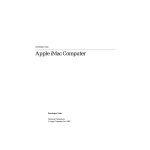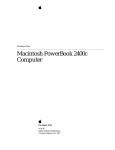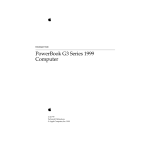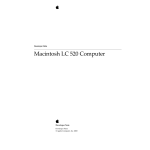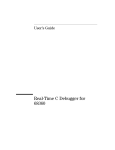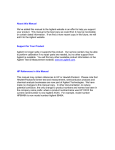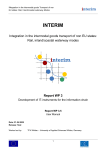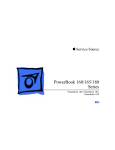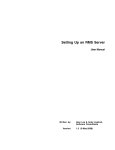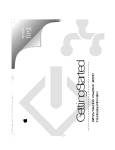Download Apple Macintosh PowerBook 160 and 180 computers Technical information
Transcript
Developer Note Macintosh PowerBook 165c Developer Note Developer Technical Publications © Apple Computer, Inc. 2000 Apple Computer, Inc. © 2000, Apple Computer, Inc. All rights reserved. No part of this publication may be reproduced, stored in a retrieval system, or transmitted, in any form or by any means, mechanical, electronic, photocopying, recording, or otherwise, without prior written permission of Apple Computer, Inc. Printed in the United States of America. The Apple logo is a registered trademark of Apple Computer, Inc. Use of the “keyboard” Apple logo (Option-Shift-K) for commercial purposes without the prior written consent of Apple may constitute trademark infringement and unfair competition in violation of federal and state laws. No licenses, express or implied, are granted with respect to any of the technology described in this book. Apple retains all intellectual property rights associated with the technology described in this book. This book is intended to assist application developers to develop applications only for Apple Macintosh computers. Apple Computer, Inc. 20525 Mariani Avenue Cupertino, CA 95014 408-996-1010 Apple, the Apple logo, APDA, AppleLink, AppleTalk, LaserWriter, and Macintosh are trademarks of Apple Computer, Inc., registered in the United States and other countries. Apple Desktop Bus, Apple SuperDrive, Macintosh Quadra, PowerBook, and QuickDraw are trademarks of Apple Computer, Inc. Adobe Illustrator and PostScript are trademarks of Adobe Systems Incorporated, which may be registered in certain jurisdictions. America Online is a service mark of Quantum Computer Services, Inc. CompuServe is a registered service mark of CompuServe, Inc. FrameMaker is a registered trademark of Frame Technology Corporation. Helvetica and Palatino are registered trademarks of Linotype Company. Internet is a trademark of Digital Equipment Corporation. ITC Zapf Dingbats is a registered trademark of International Typeface Corporation. NuBus is a trademark of Texas Instruments. Varityper is a registered trademark of Varityper, Inc. Simultaneously published in the United States and Canada. LIMITED WARRANTY ON MEDIA AND REPLACEMENT If you discover physical defects in the manual or in the media on which a software product is distributed, APDA will replace the media or manual at no charge to you provided you return the item to be replaced with proof of purchase to APDA. ALL IMPLIED WARRANTIES ON THIS MANUAL, INCLUDING IMPLIED WARRANTIES OF MERCHANTABILITY AND FITNESS FOR A PARTICULAR PURPOSE, ARE LIMITED IN DURATION TO NINETY (90) DAYS FROM THE DATE OF THE ORIGINAL RETAIL PURCHASE OF THIS PRODUCT. Even though Apple has reviewed this manual, APPLE MAKES NO WARRANTY OR REPRESENTATION, EITHER EXPRESS OR IMPLIED, WITH RESPECT TO THIS MANUAL, ITS QUALITY, ACCURACY, MERCHANTABILITY, OR FITNESS FOR A PARTICULAR PURPOSE. AS A RESULT, THIS MANUAL IS SOLD “AS IS,” AND YOU, THE PURCHASER, ARE ASSUMING THE ENTIRE RISK AS TO ITS QUALITY AND ACCURACY. IN NO EVENT WILL APPLE BE LIABLE FOR DIRECT, INDIRECT, SPECIAL, INCIDENTAL, OR CONSEQUENTIAL DAMAGES RESULTING FROM ANY DEFECT OR INACCURACY IN THIS MANUAL, even if advised of the possibility of such damages. THE WARRANTY AND REMEDIES SET FORTH ABOVE ARE EXCLUSIVE AND IN LIEU OF ALL OTHERS, ORAL OR WRITTEN, EXPRESS OR IMPLIED. No Apple dealer, agent, or employee is authorized to make any modification, extension, or addition to this warranty. Some states do not allow the exclusion or limitation of implied warranties or liability for incidental or consequential damages, so the above limitation or exclusion may not apply to you. This warranty gives you specific legal rights, and you may also have other rights which vary from state to state. Contents Figures Preface v About This Developer Note vii Supplementary Documents vii Conventions and Abbreviations viii Typographical Conventions viii Standard Abbreviations viii Chapter 1 Hardware 1 Introduction 2 Features 2 Compatibility Issues 5 Color Display 5 RAM Expansion Slot 5 Hardware Overview 6 Memory Map 6 ROM 8 ROM Wait States 8 RAM 8 RAM Wait States 9 Battery Backup 9 Color LCD Interface 9 LCD Screen 10 RAM Expansion Interface 10 Chapter 2 Software 13 ROM Software 14 System Software 14 Identifying the PowerBook 165c Control Panel Changes 14 14 iii Figures Chapter 1 Hardware Figure 1-1 Figure 1-2 Figure 1-3 Figure 1-4 Figure 1-5 1 Block diagram of the PowerBook 165c computer 32-bit memory and detailed I/O map 7 32-bit and 24-bit memory map comparison 8 Location of the RAM expansion connector 11 RAM expansion card design guide 12 4 v P R E F A C E About This Developer Note This document describes the Macintosh PowerBook 165c computer, emphasizing those features that are new or different from other Macintosh PowerBook computers. It is written primarily for experienced Macintosh hardware and software developers who want to create products that are compatible with this new computer. If you are unfamiliar with the Macintosh or would simply like more technical information on the hardware, you may want to read the related technical manuals listed in the following section. Supplementary Documents 0 Because the Macintosh PowerBook 165c computer shares many features of the Macintosh PowerBook 160/180 computers, you should refer to the Macintosh PowerBook 160 and Macintosh PowerBook 180 Developer Note for information about features not described in detail here. The Macintosh PowerBook 160 and Macintosh PowerBook 180 Developer Note is available from APDA as part of Macintosh Developer Notes: Number 1, APDA part number R0451LL/A. To supplement the information in this document, you might wish to obtain related documentation such as Guide to the Macintosh Family Hardware, second edition, Designing Cards and Drivers for the Macintosh Family, third edition, and Inside Macintosh. For detailed information about the Motorola 68030 microprocessor used in the Macintosh PowerBook 165c, refer to the MC68030 Enhanced 32-Bit Microprocessor User’s Manual. All of these documents are available through APDA. APDA is Apple’s worldwide source for over three hundred development tools, technical resources, training products, and information for anyone interested in developing applications on Apple platforms. To order products or to request a complimentary copy of the APDA Tools Catalog, contact APDA Apple Computer, Inc. P.O. Box 319 Buffalo, NY 14207-0319 Telephone 800-282-2732 (United States) 800-637-0029 (Canada) 716-871-6555 (International) Fax 716-871-6511 AppleLink APDA vii P R E F A C E America Online APDA CompuServe 76666,2405 Internet [email protected] Conventions and Abbreviations 0 This developer note uses typographical conventions and abbreviations that are standard in Apple publications. Typographical Conventions 0 Computer-language text—any text that is literally the same as it appears in computer input or output—appears in Courier font. Standard Abbreviations 0 Standard units of measure used in Apple reference books include: A amperes MB megabytes GB gigabytes MHz megahertz Hz hertz ms milliseconds K 1024 ns nanoseconds KB kilobytes V volts mA milliamperes W watts Standard abbreviations used in Apple reference books include: viii $n hexadecimal value n AC alternating current ADB Apple Desktop Bus CLUT color look-up table DAC digital-to-analog converter IC integrated circuit ASIC application-specific integrated circuit MMU memory-management unit RAM random-access memory RAMDAC random-access memory, digital/analog converter ROM read-only memory RGB red-green-blue (a video display system used by Apple computers) P R E F A C E SCSI Small Computer System Interface SVGA super VGA (a video display system used with PC-type computers) VGA video graphics adapter (a video display system used with PC-type computers) VRAM video RAM ix C H A P T E R Figure 1-0 Listing 1-0 Table 1-0 1 Hardware 1 C H A P T E R 1 Hardware This chapter describes the major features of the Macintosh PowerBook 165c computer, emphasizing the similarities and differences between it and other Macintosh PowerBook computers. IMPORTANT Only the major differences between the PowerBook 165c and the PowerBook 160/180 are described in detail here. For a complete understanding of the PowerBook 165c computer, refer to the Macintosh PowerBook 160 and Macintosh PowerBook 180 Developer Note. ▲ Introduction 1 The Macintosh PowerBook 165c brings color to the Macintosh PowerBook family of notebook computers. In addition to its vivid color display, the Macintosh PowerBook 165c offers 33 MHz performance, video output, more room for memory expansion cards, and a distinctive new exterior design. Features 1 The major features of the Macintosh PowerBook 165c computer are: ■ Microprocessor: Motorola 68030 running at 33 MHz. A 16 MHz power saving mode can be selected by the user. ■ Coprocessor: Motorola 68882 FPU running at 33 MHz. ■ Read-only memory (ROM): 1 MB. ■ Random-access memory (RAM): 4 MB of pseudostatic RAM (PSRAM). ■ ■ ■ RAM expansion: a RAM expansion slot accommodates RAM expansion cards of up to 10 MB, for a total of 14 MB of RAM. The RAM expansion slot is compatible with cards designed for earlier Macintosh PowerBook models, while providing more room for larger cards. Liquid crystal display (LCD): 8-bit color video circuitry displays up to 256 colors on the built-in 640 x 400 pixel film supertwist nematic (FSTN) LCD. The display is backlit by two cold cathode fluorescent lamps. Video output: 8-bit color video output circuitry displays up to 256 colors on all Apple color monitors up to 16 inches in size. The Apple Portrait monitor is also supported at up to 16 shades of gray. The video output circuitry is identical to that of the PowerBook 160 and PowerBook 180, supporting both dual mode and video mirror mode. In dual mode, the LCD and external monitor are independent. In video mirror mode, the image on the external monitor is identical to what is displayed on the LCD. 2 Introduction C H A P T E R 1 Hardware ■ ■ ■ ■ ■ ■ ■ ■ ■ ■ Floppy disk: one internal 1.4 MB Apple SuperDrive with Super Woz Integrated Machine (SWIM) interface. Hard disk: one internal 2.5-inch SCSI hard disk drive. Disk capacities of 80 and 120 MB are offered. SCSI disk mode: by connecting an HDI-30 SCSI Disk Adapter cable, users can access the PowerBook’s internal hard disk from another Macintosh. I/O (input/output): one HDI-30 connector for external SCSI devices, one 4-pin mini-DIN ADB port, two 8-pin mini-DIN serial ports, audio input and output jacks, and a custom video output connector with adapter for attaching standard Apple video cables. Sound: enhanced Apple Sound Chip (ASC) audio circuitry provides sound input and output through the built-in microphone and speaker. Stereo sound output can be heard through the headphone jack. Keyboard: built-in keyboard with integral 30-mm trackball. Modem: internal 20-pin connector for an optional modem card. This slot is physically and electrically compatible with modems designed for the PowerBook 160/180. Battery: a 2.9 ampere-hour NiCad rechargeable battery is included. A 3 V lithium battery provides backup power for the real-time clock and parameter RAM when the main battery is removed. Power supply: a new 24 W external wall-mounted recharger/power adapter is included. Security connector: a connector on the back panel allows users to attach a security device. ■ Weight: 7 pounds. ■ Size: 11.3 inches wide, 9.3 inches deep, and 2.3 inches high. The block diagram shown in Figure 1-1 illustrates the major hardware components of the PowerBook 165c computer. Features 3 C H A P T E R 1 Hardware Figure 1-1 Block diagram of the PowerBook 165c computer 256K x 16 DRAM D15–0 A31–0 D31–16 Pangola bus interface WD90C26 A18–0 WD90C55 A12–9 CPU Address bus A31–0 MC68030 Data bus D31–0 D31-24 A23-0 Video controller D31-16 33 MHz A20-0 RAMDAC CLUT OSC Video RAM A20–2 Monitor connector RAM expansion connector A20–2 D31–0 D31–0 PSRAM 4 MB Trackball D31–0 Data bus D31–0 D31–24 I/O data buffer Apple Desktop Bus port D31–24 Power Manager CPU GLU Battery charger and power supply ROM 1 MB A19–2 D25, 24 A31–13, 1, 0 RTC D31–0 Address buffers MC68882 33 MHz VIA1 D31–24 A4–1 FPU Flat-panel display Keyboard controller Internal modem connector D31–24 Misc. GLU Port A Channel A Drivers (modem) and Channel B receivers Port B (printer) Battery A6–4, 2, 1 Combo SCC/SCSI D31–24 Serial ports Internal floppy disk connector D31–24 A12–9 Keyboard Internal hard disk connector SWIM External SCSI port Sound input jack MUX A11–0 Enhanced ASC DFAC Filter/amp 4 Features Internal microphone External sound jack Internal speaker C H A P T E R 1 Hardware Compatibility Issues 1 Because the Macintosh PowerBook 165c is identical in most respects to the Macintosh PowerBook 160/180 computers, most hardware and software designed for those models will operate without modification on the PowerBook 165c. This section highlights key areas you should investigate in order to ensure that your products work properly with the PowerBook 165c. These topics are covered in more detail in subsequent sections. Color Display 1 The internal display controller is optimized for 8-bit color mode. Although 1-, 2-, and 4-bit modes are supported for compatibility, they provide no significant improvement in display performance. The LCD controller circuitry includes a 256-entry color look-up table (CLUT) and is compatible with software that uses QuickDraw and the Palette Manager. The controller supports a palette of 262,143 colors. However, due to the nature of LCD technology, some colors are dithered or exhibit noticeable flicker. Apple has developed a new gamma table for this display that minimizes flicker and optimizes available colors. With this gamma table in place, the effective range of the CLUT is 4096 colors. See the section “Color LCD Interface” on page 9 for more information about the internal display hardware and LCD screen. The external video interface of the Macintosh PowerBook 165c computer is identical to the PowerBook 160/180 in all respects. Note MacsBug version 6.2.2 does not properly restore the LCD frame buffer on the Macintosh PowerBook 165c. The screen can be restored by forcing a redraw. This problem will be corrected in future MacsBug versions. ◆ RAM Expansion Slot 1 The RAM expansion slot is compatible with RAM expansion cards meeting Apple design specifications for the Macintosh PowerBook 180 and earlier models. However, the design of the PowerBook 165c provides more physical space for RAM expansion cards than was specified for earlier PowerBook computers. Developers must follow the design guidelines provided in the section “RAM Expansion Interface” on page 10 to assure compatibility with the Macintosh PowerBook 165c and future models. ▲ W AR N I N G Do not exceed the design envelope shown in Figure 1-5. Cards that exceed these specifications may damage the computer, and may be incompatible with future PowerBook models. ▲ Compatibility Issues 5 C H A P T E R 1 Hardware Hardware Overview 1 This section discusses the hardware differences between the Macintosh PowerBook 165c and the Macintosh PowerBook 160/180 computers. IMPORTANT Memory sizes, addresses, and other data are specific to each type of Macintosh computer and are provided for informational purposes only. To ensure that your application software maintains compatibility across the Macintosh line and to allow for future hardware changes, you are strongly advised to use the Macintosh Toolbox and Operating System routines wherever provided. In particular, never use absolute addresses to access hardware, because these addresses are not the same for all models. ▲ Memory Map 1 Like all Macintosh PowerBook computers that use the 68030 microprocessor, the PowerBook 165c always operates in 32-bit addressing mode. To maintain compatibility with software that uses 24-bit addressing conventions, the memory management unit (MMU) in the 68030 is used to map 24-bit addresses to their 32-bit equivalent. In 32-bit mode, the 68030 supports a 4 GB address space. In 24-bit mode, however, the upper 8 address bits are ignored, and the maximum address space is limited to 16 MB. The MMU remaps addresses so that RAM, ROM, VRAM, and I/O all appear within this 16 MB range. Although the address translation is transparent to software, it has the effect of limiting the amount of addressable RAM to 8 MB. Figure 1-2 shows the 32-bit memory map of the PowerBook 165c. Figure 1-3 compares the 24-bit and 32-bit memory maps. 6 Hardware Overview C H A P T E R 1 Hardware Figure 1-2 32-bit memory and detailed I/O map Expansion I/O space (no DSACKs) $FFFF FFFF $FEF0 FFFF Reserved $FE00 0000 Slot E (external video) $FD00 0000 Reserved $FC00 0000 Slot C (internal video) Reserved $6000 0000 $5000 0000 I/O $4400 0000 Reserved $4000 0000 ROM Expansion RAM (bus error) $0400 0000 $00E0 0000 $0000 0000 Illegal RAM 14 MB maximum, one continuous bank Hardware Overview $6000 0000 $5900 0000 Reserved $5400 0000 Reserved $5010 0000 Reserved $500C 0000 CPU GLU registers $5008 0000 Reserved $5004 0000 Reserved $5003 0000 Reserved $5002 E000 Reserved $5002 C000 Reserved $5002 A000 Reserved $5002 8000 Reserved $5002 6000 Reserved $5002 4000 Reserved $5002 2000 Reserved $5002 0000 Reserved $5001 E000 Reserved $5001 C000 Reserved $5001 A000 Reserved $5001 8000 SWIM $5001 6000 Sound $5001 4000 SCSI (non DRQ) $5001 2000 SCSI (normal mode) $5001 0000 Reserved (SCSI wrap) $5000 E000 Reserved (SCC wrap) $5000 C000 Reserved (VIA2 wrap) $5000 A000 Reserved (VIA1 wrap) $5000 8000 SCSI (DMA with DRQ) $5000 6000 SCC $5000 4000 VIA2 $5000 2000 VIA1 $5000 0000 7 C H A P T E R 1 Hardware Figure 1-3 32-bit and 24-bit memory map comparison 32-bit memory map $FFFF FFFF $FEF0 FFFF 24-bit memory map Reserved $FF FFFF $F0 0000 I/O space $FE00 0000 Slot E (external video) $E0 0000 Slot E (external video) $FD00 0000 Reserved $D0 0000 Reserved $FC00 0000 Slot C (internal video) $C0 0000 Slot C (internal video) Reserved Reserved $90 0000 $6000 0000 $5000 0000 I/O $4400 0000 Reserved $4000 0000 ROM $80 0000 Expansion RAM (bus error) ROM RAM 8 MB maximum, one continuous bank $0400 0000 Illegal $00E0 0000 $0000 0000 RAM 14 MB maximum, one continuous bank $00 0000 ROM 1 The Macintosh PowerBook 165c ROM is identical to the ROM used in the PowerBook 160 and PowerBook 180 computers. The ROM chips have been moved from the secondary logic board to a new RAM/ROM board to make room for the color display circuits. A new 32K x 8-bit declaration ROM appears in NuBus™ slot $C address space and provides firmware support for the color LCD. ROM Wait States 1 ROM accesses by the CPU require 4 processor wait states (7 clock cycles at 33 MHz), which is equivalent to 180 ns per access. RAM 1 The PowerBook 165c includes 4 MB of 85 ns pseudostatic RAM, consisting of eight 512K x 8-bit chips. The RAM chips are contained on a new RAM/ROM board to provide room for the color display circuitry on the secondary logic board. 8 Hardware Overview C H A P T E R 1 Hardware The RAM expansion slot is located on the RAM/ROM board, and supports up to 10 MB of PSRAM, for a total of 14 MB. See the “RAM Expansion Interface” section on page 10 for information about designing RAM expansion cards. RAM is always contiguous because only one size of RAM chip (4 Mbits) is used. As a result, software does not have to “stitch” memory. The RAM array is located in the system memory map between addresses $0000 0000 and $00DF FFFF, except following a system reset or sleep cycle, when it is overlaid by system ROM. However, the overlay is removed following access to normal ROM space, and the RAM space is then accessible. Both RAM and ROM memory spaces provide DSACK signals to the processor even if memory is not actually installed. The RAM data path is 32 bits wide. RAM Wait States 1 RAM accesses require 2 wait states when using 85 ns PSRAM exclusively. Installing 100 ns expansion RAM causes the memory controller to insert an additional wait state in all memory accesses (both main and expansion). Battery Backup 1 Both main and expansion RAM are backed up when the computer is in the sleep state, as long as the battery is charged or the power adapter is plugged in. RAM contents are not maintained when the computer is turned off or when the battery is removed. Color LCD Interface 1 The color display circuitry in the Macintosh PowerBook 165c emulates a NuBus video card installed in slot $C. This circuitry includes the LCD controller chip set, 512 KB of DRAM, and a declaration ROM. The PowerBook 165c is compatible with software that uses QuickDraw and the Palette Manager. Color table animation is also supported. The LCD controller chip set consists of the WD90C26 controller and WD90C55 display driver, both made by Western Digital, and the Pangola bus interface chip, an Apple custom ASIC that translates signals between the WD90C26 and the 68030 bus. Pangola also handles the frame buffer conversion necessary to support 1-, 2-, and 4-bit color modes with the Western Digital controller. The WD90C26 contains a 256-entry CLUT, RAMDAC, frame buffer controller, and flat panel control circuitry. Although the CLUT supports a palette of 262,143 colors, many of the possible colors do not look acceptable on the display. Due to the nature of LCD technology, some colors are dithered or exhibit noticeable flicker. Apple has developed a new gamma table for this display that minimizes flicker and optimizes available colors. With this gamma table in place, the effective range of the CLUT is 4096 colors. The frame buffer appears to the 68030 as a continuous RAM array of 512 KB beginning at $FC04 0000. The data path is 16 bits wide and byte addressable. The frame buffer is controlled by the WD90C26, which allocates 1 byte per pixel in all color modes. Because Color LCD Interface 9 C H A P T E R 1 Hardware the WD90C26 manages its frame buffer differently than QuickDraw expects, Pangola must perform byte packing and unpacking to support color modes other than 8-bit. For example, in 1-bit mode QuickDraw expects that each byte in the frame buffer represents eight pixels. For every byte QuickDraw writes to the frame buffer in 1-bit mode, Pangola unpacks the bits and sends 8 bytes to the WD90C26. Similarly, Pangola must pack 8 bytes into 1 byte each time QuickDraw reads a byte from the frame buffer in 1-bit mode. Because the WD90C26 is optimized for 8-bit color mode, there is little advantage to selecting a reduced bit depth. Apple recommends that application developers use 8-bit mode whenever possible on the Macintosh PowerBook 165c. Applications that manipulate the frame buffer directly must do so at a consistent bit depth because Pangola always interprets pixel data based on the current video mode. For example, attempting to write 8-bit data to the frame buffer while in 1-bit mode will corrupt the frame buffer because Pangola will unpack each byte as described above. Sending 1-bit data to the buffer while in 8-bit mode produces similar results because Pangola will not perform the necessary conversion. LCD Screen 1 The PowerBook 165c uses a high-contrast 640 x 400 pixel FSTN color display with .30 mm dot pitch. The display is backlit by two CCFL bulbs located at the top and bottom of the panel. The inherent differences between LCD and CRT technologies make it a challenge to precisely match colors displayed on the LCD with those on an external monitor. The PowerBook 165c gamma table provides good color matching while minimizing flicker. Developers should use the supplied gamma table unless there is a specific need to replace it. Using a gamma table developed for RGB systems will produce poor results. RAM Expansion Interface 1 The PowerBook 165c accommodates RAM expansion cards from 2 MB to 10 MB in capacity, for a total of 14 MB RAM. The RAM expansion interface is electrically identical to that of the PowerBook 180. However, the design of the PowerBook 165c provides more physical space for RAM expansion cards than was specified for earlier PowerBook computers, making it easier for developers to design high capacity cards. The RAM expansion slot is located on the RAM/ROM board, in the same position as earlier PowerBook models. Figure 1-4 shows the location of the RAM expansion connector. Figure 1-5 shows the mechanical design guide for PowerBook 165c RAM expansion cards. Refer to the Macintosh PowerBook 160 and Macintosh PowerBook 180 Developer Note for electrical design guidelines. 10 RAM Expansion Interface C H A P T E R 1 Hardware Figure 1-4 Location of the RAM expansion connector RAM expansion connector Modem connector Back 20 1 70 Main logic board 2 2 1 RAM/ROM board Floppy drive Secondary logic board Battery CPU heat sink Hard drive Front RAM Expansion Interface 11 C H A P T E R 1 Hardware Figure 1-5 RAM expansion card design guide 51.0 -A2 16.0 9.0 42.0 2 3.00 maximum component height in indicated area. 1.50 maximum component height in indicated area. 3 1.00 maximum component height in indicated area. 4 No components or exposed conductors permitted in indicated area. 5 AMP connector, P/N 104652-7 or equivalent. 1 3 17.0 PCB 4 1.14 5 REF 16.0 3 REF 2 REF 3 1 REF 4 47.54 0.2 S A 4 5.71 0.2 S B 9.0 17.0 4 5 3 21.0 to conn CL Pin 1 -B- 21.0 to conn CL 2.5 1 2 25.5 to conn CL Dimensions are in millimeters. ▲ W AR N I N G Do not exceed the design guidelines shown in Figure 1-5. Cards that exceed these specifications may damage the computer, and may be incompatible with future PowerBook models. ▲ 12 RAM Expansion Interface 2.5 C H A P T E R Figure 2-0 Listing 2-0 Table 2-0 Software 2 2 C H A P T E R 2 Software This chapter describes the new ROM and system software features of the PowerBook 165c computer. ROM Software 2 The PowerBook 165c uses the same ROM software as the PowerBook 160/180 computers. Support for the color display is provided by the video driver located in the declaration ROM. All other software modifications are incorporated into the system software. System Software 2 The PowerBook 165c computer is shipped with System 7.1 software. A system enabler file, included on the “Install Me First” disk, contains extensions to the system software necessary to support the PowerBook 165c. The system enabler file must be installed in the System Folder for the computer to boot. Identifying the PowerBook 165c 2 The correct method for software to identify the Macintosh model it is running on is by using the Gestalt Manager routines described in Inside Macintosh. The gestaltMachineType value returned by the PowerBook 165c is 50. This value can be used to obtain the machine name string as described in Inside Macintosh. Control Panel Changes The PowerBook and PowerBook Display control panels have been updated to support the color display and new power management profile of the PowerBook 165c. The only change visible to the user is that the PowerBook Display control panel does not turn off the backlight completely. With the backlight off, users may mistakenly think the computer is shut down, so the PowerBook Display control panel dims the backlight to a low level. 14 ROM Software 2


























